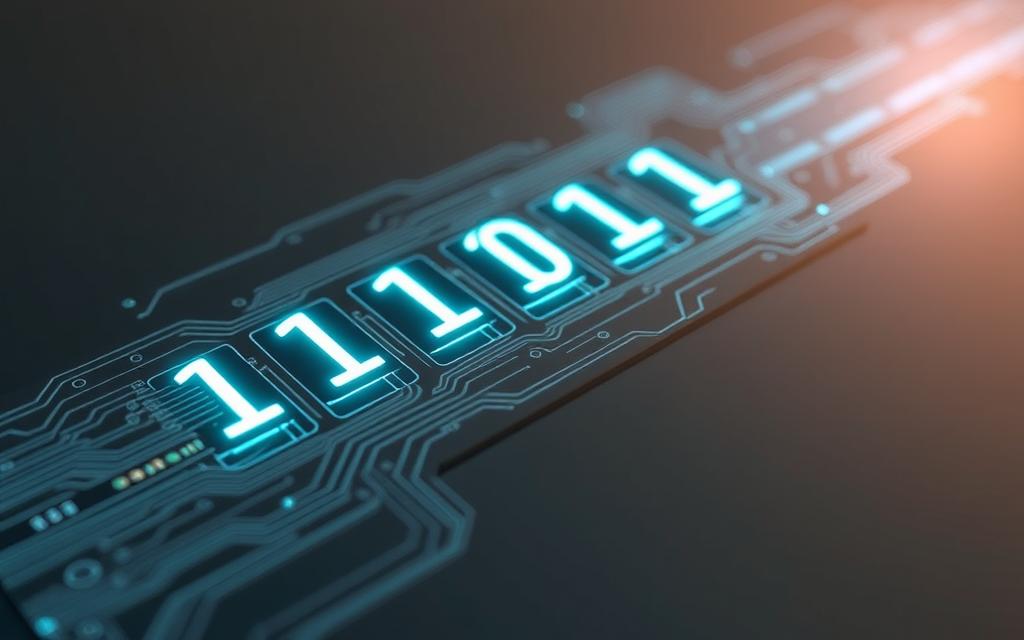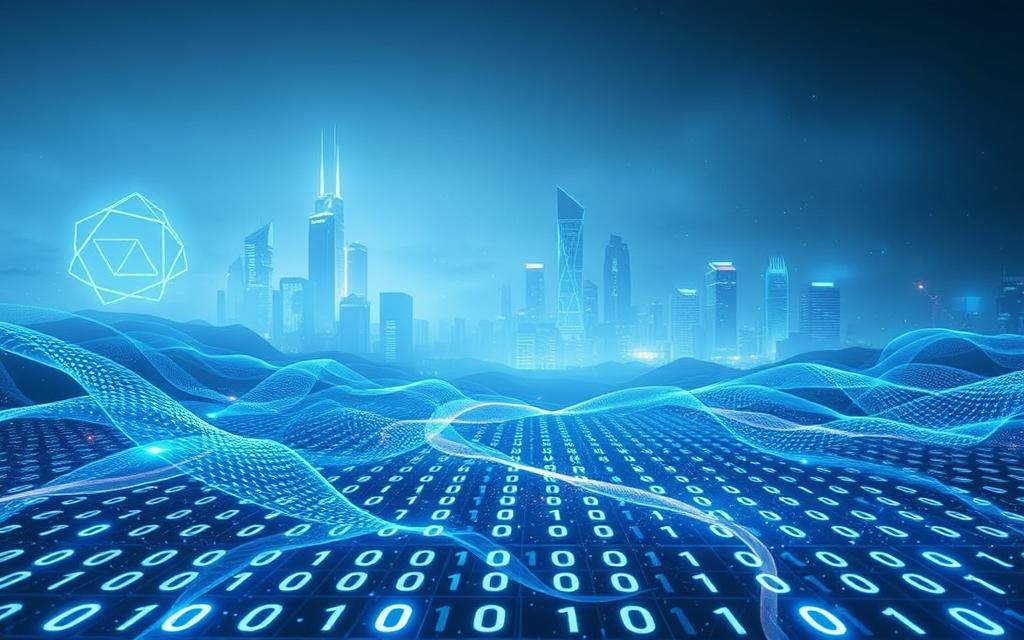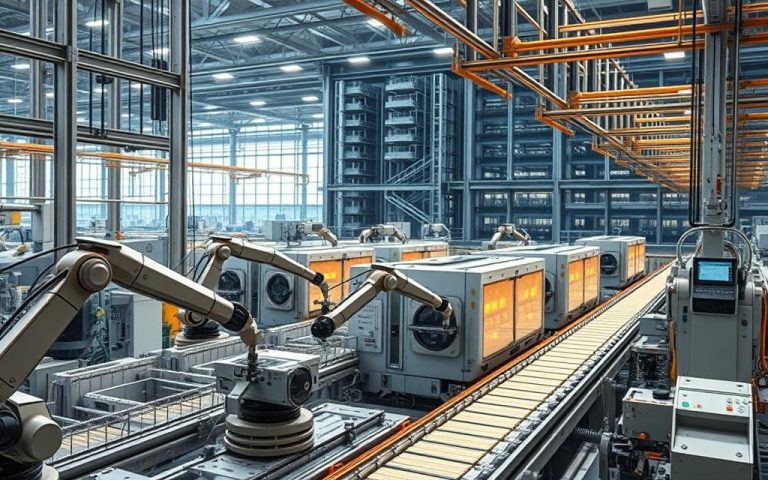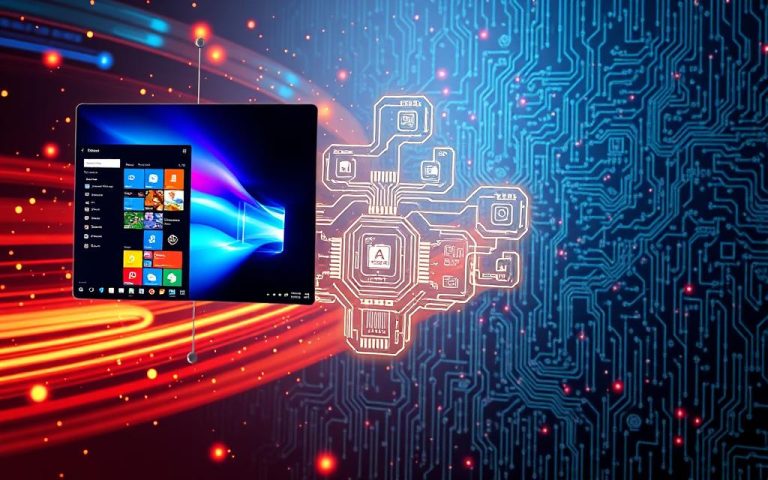The Language of Computers: Understanding Binary & Other Number Systems
Digital information in computers is represented through binary numbers. These numbers are sequences of 1s and 0s, created by electrical signals1. Binary is the foundation of digital technology, using only two digits: 0 and 12.
A binary digit, or bit, represents a value of 1 or 0. It’s like an electronic switch that can be on or off1. Transistors in computer circuits act as these small electronic switches.
Computers use binary to encode and transmit data. A byte, made up of eight bits, allows for 256 possible combinations1. This system enables complex computations through simple electrical signals.
Number systems are key to understanding how computers work. They transform electrical pulses into meaningful digital information. Binary’s simplicity makes it perfect for electronic circuitry.
Introduction to Binary: The Foundation of Computer Language
Binary code is the backbone of digital technology. It uses only two digits: 0 and 1. This simple system powers all electronic devices3.
Binary is how computers understand information. It breaks down complex data into on and off states. Each binary digit, or bit, is a basic unit of digital communication.
Exploring Binary Code Fundamentals
Binary code is remarkably simple. It uses only two digits, unlike our decimal system with ten. This simplicity allows for efficient computer processing4.
- Uses only 0 and 1 as digits
- Represents electronic on/off states
- Fundamental to digital communication
Historical Origins of Binary
Binary’s roots date back to 17th-century mathematics. Thinkers saw the potential of a two-state system long before computers. Their work laid the foundation for modern digital technology.
Why Computers Rely on Binary
Computers use binary because electronic circuits have two states: on and off. This matches binary’s dual-digit system perfectly. It’s ideal for representing digital information3.
Binary allows complex calculations through simple electrical signals. It translates intricate information into straightforward signals.
Binary: Where simplicity meets computational power
Binary’s elegance lies in its simplicity. It enables the remarkable computational capabilities we rely on today.
What number system does a computer use?
Computers operate using the binary number system. This digital data representation method forms the core of modern computing5. It uses only two digits – 0 and 1 – which align with the basic electrical states of electronic circuits6.

The binary system represents information through sequences of bits. Each bit can be in one of two states: off (0) or on (1). This simplicity enables efficient digital data processing5.
About 95% of modern computer systems rely solely on binary. It’s used for both data storage and computation5.
- Binary digits (bits) represent increasing powers of 2
- A byte consists of 8 bits, allowing 256 different values
- Binary can represent complex computational tasks
The binary system has deep historical roots. The earliest known binary-like system dates back to ancient Egypt around 2400 BC6.
Scholars like Gottfried Leibniz and Claude Shannon played key roles. They developed and established binary’s importance in computation6.
Binary is not just a number system, but the fundamental language of digital communication.
Other number systems like hexadecimal and octal exist. However, binary remains the main method for digital data representation in computers5.
Converting Between Number Systems
Number system conversion is vital in computer science. It allows for smooth communication between different computational representations. Binary-decimal conversion is key to efficient digital communication.
- Decimal (base-10)
- Binary (base-2)
- Octal (base-8)
- Hexadecimal (base-16)7
Binary to Decimal Conversion
To convert binary to decimal, multiply each digit by its power of two. Then, add up all the results. For example, 10010101 in binary equals 149 in decimal.
Decimal to Binary Conversion
For decimal to binary conversion, divide the number by 2 repeatedly. Note down the remainders. The binary form of 84 is 01010100.
Practical Applications
Binary-decimal conversion is essential in many computing areas. These include:
- Database management
- Financial software
- Hardware programming
- Embedded systems8
Understanding number system conversion unlocks the fundamental language of digital communication.
ASCII and Text Representation in Binary
ASCII encoding turns text into binary language for computers. Each ASCII character has a unique binary code. This system allows smooth communication between different computing systems9.
The standard ASCII set has 128 distinct characters. These include alphabetic, numeric, and special symbols10.
Text-to-binary conversion follows a set method. For example, ‘A’ becomes 01000001 in binary. This shows how letters change into computer language9.
Modern systems often use 8-bit representations. This expands the possible character range10.
- Printable ASCII characters range from decimal 32 to 127
- Control characters occupy decimal values 0 to 31
- Extended ASCII supports up to 256 characters
The link between binary and ASCII allows precise data transmission. This works across various computing platforms9.
| Character | Decimal | Binary (8-bit) |
|---|---|---|
| A | 65 | 01000001 |
| m | 109 | 01101101 |
| ; | 59 | 00111011 |
ASCII remains vital, but modern computing often uses Unicode. Unicode supports about 150,000 characters. This far exceeds ASCII’s capabilities10.
Beyond Binary: Other Number Systems in Computing
Computer number systems go beyond binary, showing a diverse world of numerical communication. These systems are vital in how computers process information. Each has its own unique features and uses.
We humans use the decimal system with ten digits11. This system bridges human thinking and computer processing. It helps us grasp numerical data more easily.
Exploring Computational Number Representations
Computer science uses several number systems with great flexibility:
- Decimal system (base-10): Uses digits 0-911
- Hexadecimal system (base-16): Utilises 16 symbols including 0-9 and A-F11
- Octal system (base-8): Employs digits 0-711
Hexadecimal: A Compact Representation
Hexadecimal offers a compact way to show binary data. Each hex digit matches four binary digits11. Coders often use it for memory addresses and colour codes.
It’s also handy for low-level programming tasks. Hexadecimal makes complex binary data easier to read and work with.
Octal System in Modern Computing
The octal system still matters in some computing areas. Each place in an octal number stands for a power of 811. It once offered an efficient way to show binary info clearly.
Understanding these number systems reveals the intricate language of computers.
The Role of Number Systems in Modern Computing
Number systems are vital to digital technology. They enable complex computations across various tech fields. These systems drive innovation in data storage, processing, and memory management12.
Data Storage and Memory Addressing
Computer memory uses number systems to manage information efficiently. Binary encoding allows precise data storage through unique bit configurations13.
- 1 bit can represent 2 distinct values
- 8 bits (1 byte) can represent 256 distinct values
- 64-bit systems support extensive memory addressing
Digital Signal Processing
Digital signal processing turns complex analog signals into binary form. Computers use advanced numerical methods to handle signals. This applies to audio, video, and communication technologies12.
Cryptography and Information Security
Number systems are crucial for encryption strategies. Different numerical bases create complex encoding mechanisms. These protect sensitive digital information from unauthorised access12.
Numerical representation is the silent guardian of digital communication.
| Number System | Key Characteristics | Computing Application |
|---|---|---|
| Binary | Base-2 system | Core computational processing |
| Hexadecimal | Base-16 system | Memory address representation |
| Decimal | Base-10 system | Human-readable computation |
Conclusion
Number systems form the core of digital processing. Binary is the foundation of computing, with all modern computers using binary architecture14. Number systems propel technological progress, reshaping our grasp of digital information15.
Computer language has grown more complex over time. It evolved from simple binary to sophisticated hexadecimal systems. This progress has greatly expanded our computational abilities16.
The future of digital processing looks promising. New methods of data manipulation may revolutionise how we think about computational architecture. These advancements could change how we process information.
Emerging technologies like quantum computing may transform traditional number systems. Current digital representation might be just the beginning of more advanced computational models. Understanding these systems is vital for computer science professionals.
FAQ
What is binary code?
Why do computers use binary?
How are text characters converted to binary?
What are the other number systems used in computing?
How do I convert between binary and decimal?
What is the role of number systems in modern computing?
Are there limitations to binary representation?
How do different number systems interact in computing?
Source Links
- https://www.thenational.academy/teachers/programmes/computing-secondary-ks4-gcse-ocr/units/representation-of-numbers/lessons/why-do-computers-use-binary
- https://www.techtarget.com/whatis/definition/binary
- https://www.prepbytes.com/blog/general/number-system-in-computer/
- https://www.bbc.co.uk/bitesize/guides/zfspfcw/revision/3
- https://www.toppr.com/guides/computer-aptitude-and-knowledge/basics-of-computers/number-systems/
- https://en.wikipedia.org/wiki/Binary_number
- https://www.geeksforgeeks.org/number-system-and-base-conversions/
- https://www.studysmarter.co.uk/explanations/computer-science/data-representation-in-computer-science/numeral-systems/
- https://www.totalphase.com/blog/2023/05/binary-ascii-relationship-differences-embedded-applications/?srsltid=AfmBOop7EYayqV5r1LVINuD3DoDe9EJBo2_MXPNYekSgNfHIehsK3dg3
- https://www.techtarget.com/whatis/definition/ASCII-American-Standard-Code-for-Information-Interchange
- https://dev.to/m__mdy__m/understanding-number-systems-binary-decimal-hexadecimal-and-beyond-55i4
- https://www.ccbp.in/blog/articles/number-system-in-computer-organization
- https://en.wikipedia.org/wiki/Computer_number_format
- https://www.spectroscopyonline.com/view/decimal-versus-binary-representation-of-numbers-in-computers
- https://sathee.prutor.ai/article/maths/number-system/
- https://www.prepostseo.com/p/what-is-number-system-in-computer







